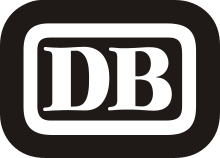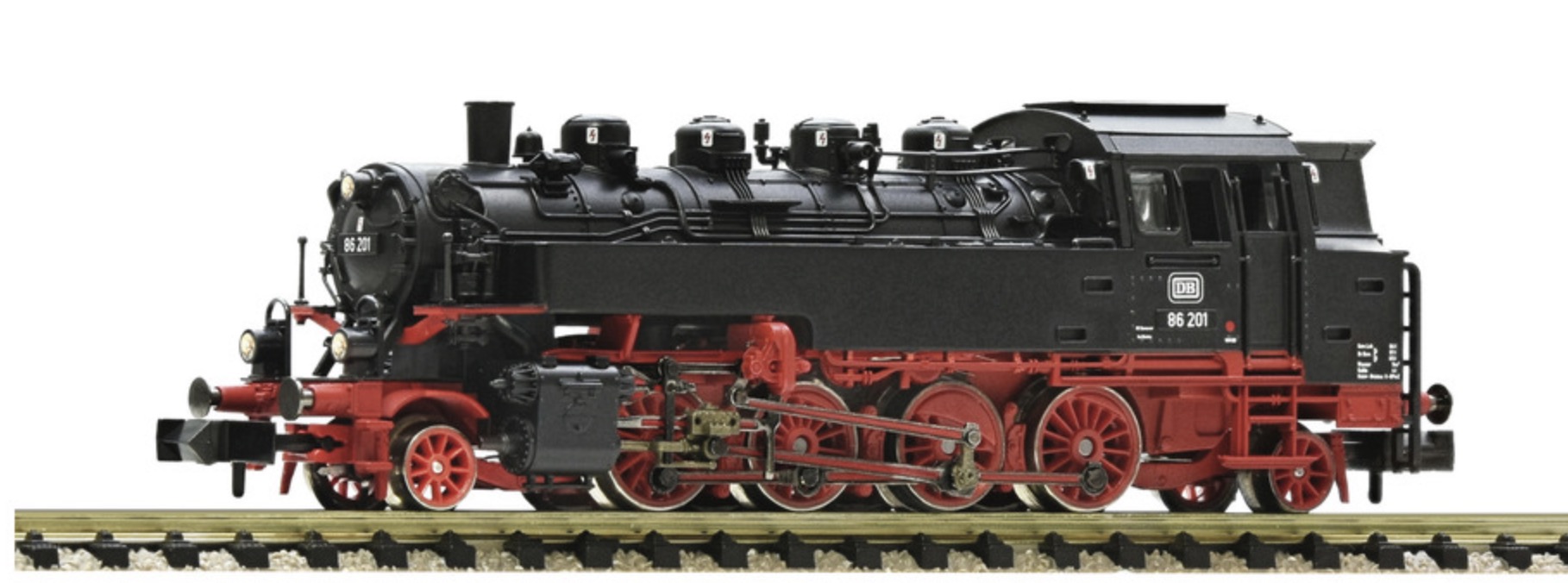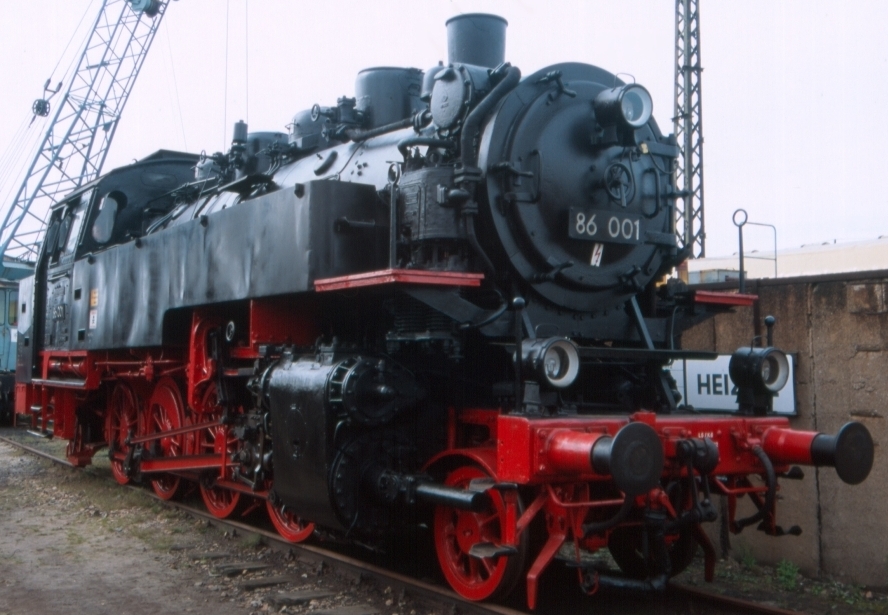Fleischmann - 7170008 - Locomotive, Steam, 2-8-2, BR 86 - Deutsche Bundesbahn - 86 201
| Stock Number | 7170008 |
| Original Retail Price | 349.90€ |
| Brand | Fleischmann |
| Manufacturer | Fleischmann |
| Body Style | Fleischmann Steam Engine Class 86 |
| Prototype Vehicle | Locomotive, Steam, 2-8-2, BR 86 (Details) |
| Road or Company Name | Deutsche Bundesbahn (Details) |
| Reporting Marks | DB |
| Road or Reporting Number | 86 201 |
| Paint Color(s) | Black and Red |
| Print Color(s) | White |
| Coupler Type | Rapido Hook NEM Standard Pocket |
| Coupler Mount | Body-Mount |
| Wheel Type | Nickel-Silver Plated Metal |
| Wheel Profile | Deep Flange |
| DCC Readiness | DC/DCC Dual Mode Decoder w/Sound |
| Release Date | 2024-06-01 |
| Item Category | Locomotives |
| Model Type | Steam |
| Model Subtype | BR |
| Model Variety | 86 |
| Prototype Region | Europe |
| Prototype Era | EU Epoch II (1920 - 1945) |
| Years Produced | 1928 - 1943 |
| Scale | 1/160 |
Prototype History:
The DRG Class 86 was a standard (see Einheitsdampflokomotive) goods train tank locomotive with the Deutsche Reichsbahn-Gesellschaft. It was intended for duties on branch lines and was delivered by almost all the locomotive building firms working for the Reichsbahn. From 1942 it was built in a simplified version as a 'transitional war locomotive' (Übergangskriegslokomotive or ÜK). The most obvious changes were the omission of the second side windows in the cab and the solid disc carrying wheels.
Almost all German locomotive factories took part in building these engines, 775 examples being produced in the period from 1928 to 1943. Its area of operations was predominantly the routes in Germany's central mountains (Mittelgebirge); as a result the first 10 units were given a Riggenbach counter-pressure brake. Twenty locomotives were destroyed during the Second World War; lightly damaged engines were repaired. Of the original 775 units, 175 went to the GDR railways, 385 to the Deutsche Bundesbahn, 29 to the Austrian Federal Railways (ÖBB), 44 to the PKP in Poland as the Class TKt3, 73 to the SZD and 62 to the CSD (6 of which later went to the SZD and 86 043 in 1958 to the GDR). On the last-mentioned 62 engines 28 became the CSD Class 455.2. Only 2 engines are still unaccounted for (86 016 and 86 469). The ÖBB began to retire them as early as 1945, but the last did not retire until 1972. However the Austrian engines had some of the most spectacular duties, including working double-headed on heavy, empty, ore trains with a DRB Class 52.
Almost all German locomotive factories took part in building these engines, 775 examples being produced in the period from 1928 to 1943. Its area of operations was predominantly the routes in Germany's central mountains (Mittelgebirge); as a result the first 10 units were given a Riggenbach counter-pressure brake. Twenty locomotives were destroyed during the Second World War; lightly damaged engines were repaired. Of the original 775 units, 175 went to the GDR railways, 385 to the Deutsche Bundesbahn, 29 to the Austrian Federal Railways (ÖBB), 44 to the PKP in Poland as the Class TKt3, 73 to the SZD and 62 to the CSD (6 of which later went to the SZD and 86 043 in 1958 to the GDR). On the last-mentioned 62 engines 28 became the CSD Class 455.2. Only 2 engines are still unaccounted for (86 016 and 86 469). The ÖBB began to retire them as early as 1945, but the last did not retire until 1972. However the Austrian engines had some of the most spectacular duties, including working double-headed on heavy, empty, ore trains with a DRB Class 52.
Road Name History:
 Deutsche Bundesbahn was the Western Germany DB before reunification. After World War II, Germany (and the DRG) was divided into 4 zones: US, British, French and Soviet. The first three eventually combined to form the Federal Republic of Germany (the West) and the Russian zone became the German Democratic Republic (the East). German territories beyond the Oder were ceded to Poland except for the northern part of East Prussia, which was ceded to the Soviet Union in 1945.
Deutsche Bundesbahn was the Western Germany DB before reunification. After World War II, Germany (and the DRG) was divided into 4 zones: US, British, French and Soviet. The first three eventually combined to form the Federal Republic of Germany (the West) and the Russian zone became the German Democratic Republic (the East). German territories beyond the Oder were ceded to Poland except for the northern part of East Prussia, which was ceded to the Soviet Union in 1945.
From 1949, the new governments assumed authority for railway operations. The DRG's (or DR's) successors were named Deutsche Bundesbahn (DB, German Federal Railways) in West Germany, and Deutsche Reichsbahn (DR, German State Railways) in East Germany kept the old name to hold tracking rights in western Berlin.
Unlike the DRG, which was a corporation, both the DB and the DR were federal state institutions, directly controlled by their respective transportation ministries. Railway service between East and West was restricted; there were around five well-controlled and secure checkpoints between West and East Germany, and about the same number between East Germany and West Berlin. Four transit routes existed between West Germany and West Berlin; citizens of West Berlin and West Germany were able to use these without too much harassment by the East German authorities.
The DB started in 1968 with changing the locomotive and passenger car serial numbers to the UIC norm. In 1970 the DR followed. The DB started experimenting with the Intercity trains in a new livery (bright orange).
In 1989, the Wall fell. Train frequency rapidly increased on the existing East/West corridors; closed links which had formerly crossed the border were re-opened. On 3 October 1990, Germany was reunified; however, this was not immediately the case with the railways. Administrative and organisational problems led to the decision to completely re-organize and reconnect Germany's railways. The so-called Bahnreform (Railway Reform) came into effect on 1 January 1994, when the State railways Deutsche Bundesbahn and Deutsche Reichsbahn were formally reunited to form the current German Railway Corporation (Deutsche Bahn).
From Wikipedia

From 1949, the new governments assumed authority for railway operations. The DRG's (or DR's) successors were named Deutsche Bundesbahn (DB, German Federal Railways) in West Germany, and Deutsche Reichsbahn (DR, German State Railways) in East Germany kept the old name to hold tracking rights in western Berlin.
Unlike the DRG, which was a corporation, both the DB and the DR were federal state institutions, directly controlled by their respective transportation ministries. Railway service between East and West was restricted; there were around five well-controlled and secure checkpoints between West and East Germany, and about the same number between East Germany and West Berlin. Four transit routes existed between West Germany and West Berlin; citizens of West Berlin and West Germany were able to use these without too much harassment by the East German authorities.
The DB started in 1968 with changing the locomotive and passenger car serial numbers to the UIC norm. In 1970 the DR followed. The DB started experimenting with the Intercity trains in a new livery (bright orange).
In 1989, the Wall fell. Train frequency rapidly increased on the existing East/West corridors; closed links which had formerly crossed the border were re-opened. On 3 October 1990, Germany was reunified; however, this was not immediately the case with the railways. Administrative and organisational problems led to the decision to completely re-organize and reconnect Germany's railways. The so-called Bahnreform (Railway Reform) came into effect on 1 January 1994, when the State railways Deutsche Bundesbahn and Deutsche Reichsbahn were formally reunited to form the current German Railway Corporation (Deutsche Bahn).
From Wikipedia
Brand/Importer Information:
As a high-quality company we set the standard when it comes to prototype fidelity and functionality. Our aim is to enthrall novices and experts alike and to be the enduring long-term partner for a fascinating hobby that spans all generations. We achieve this with the true-to-detail design and the reliability of our models and with innovations that offer a new dimension in the play value and fun factor. The high commitment to quality that has characterised Fleischmann for more than 125 years has ensured our company?s position as an internationally leading brand for model railways.
Small-scale greatness. Its comprehensive range in the N scale makes Fleischmann the international market leader in this sector. There are over 350 highly detailed models to choose from in the space-saving 9-mm gauge. Continuous and targeted extension of the range will allow Fleischmann to expand its competitive edge in the future.
Small-scale greatness. Its comprehensive range in the N scale makes Fleischmann the international market leader in this sector. There are over 350 highly detailed models to choose from in the space-saving 9-mm gauge. Continuous and targeted extension of the range will allow Fleischmann to expand its competitive edge in the future.
Item created by: CNW400
on 2024-06-25 21:32:15
If you see errors or missing data in this entry, please feel free to log in and edit it. Anyone with a Gmail account can log in instantly.
If you see errors or missing data in this entry, please feel free to log in and edit it. Anyone with a Gmail account can log in instantly.





